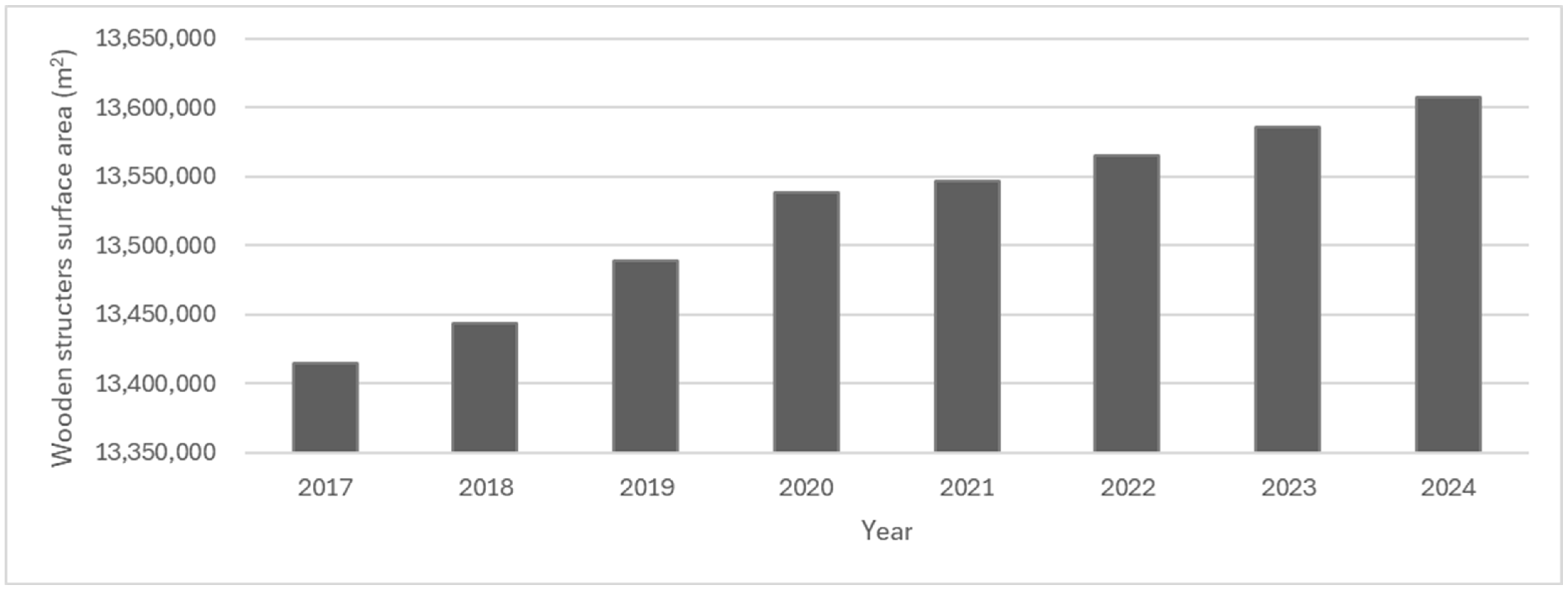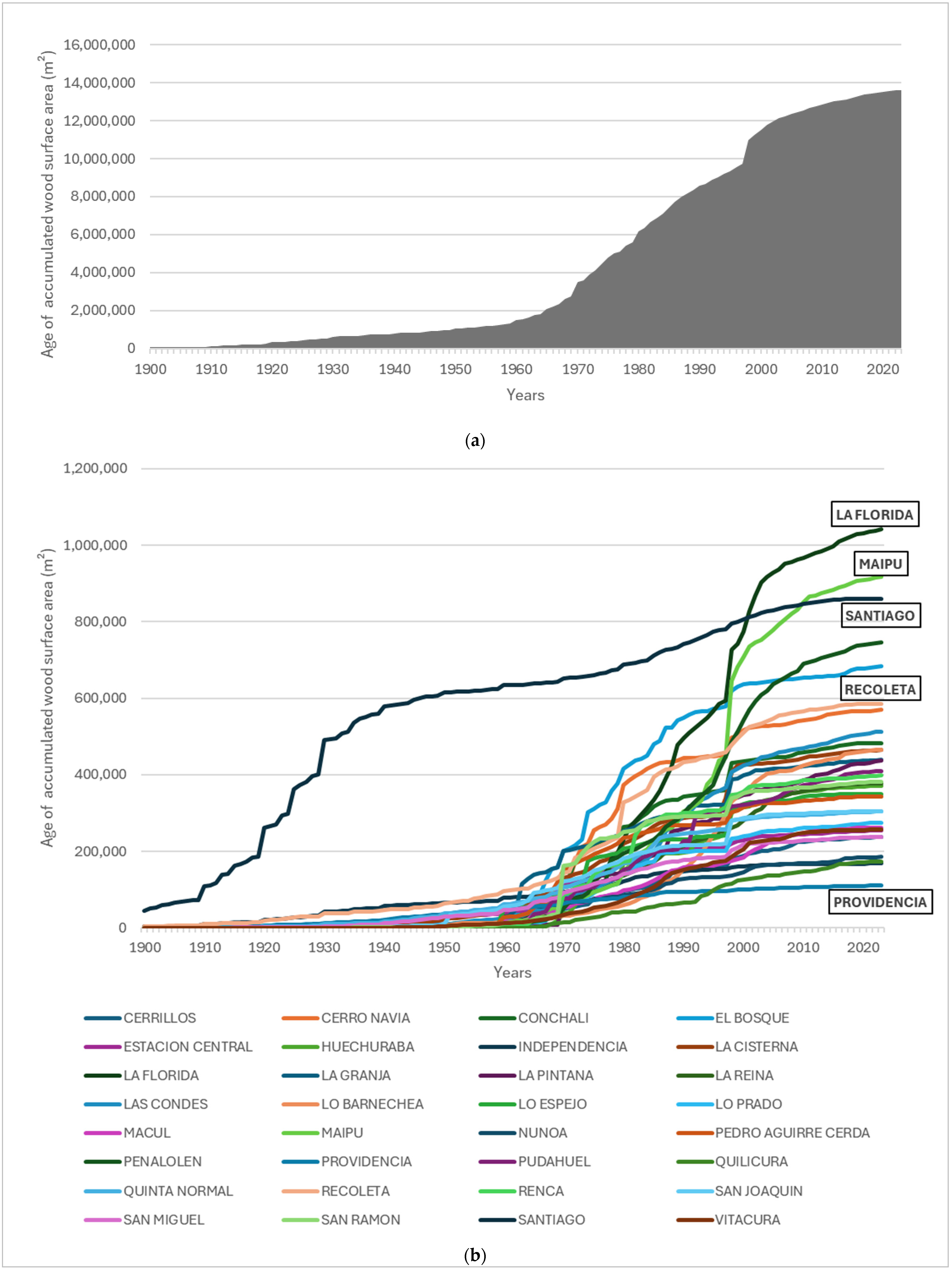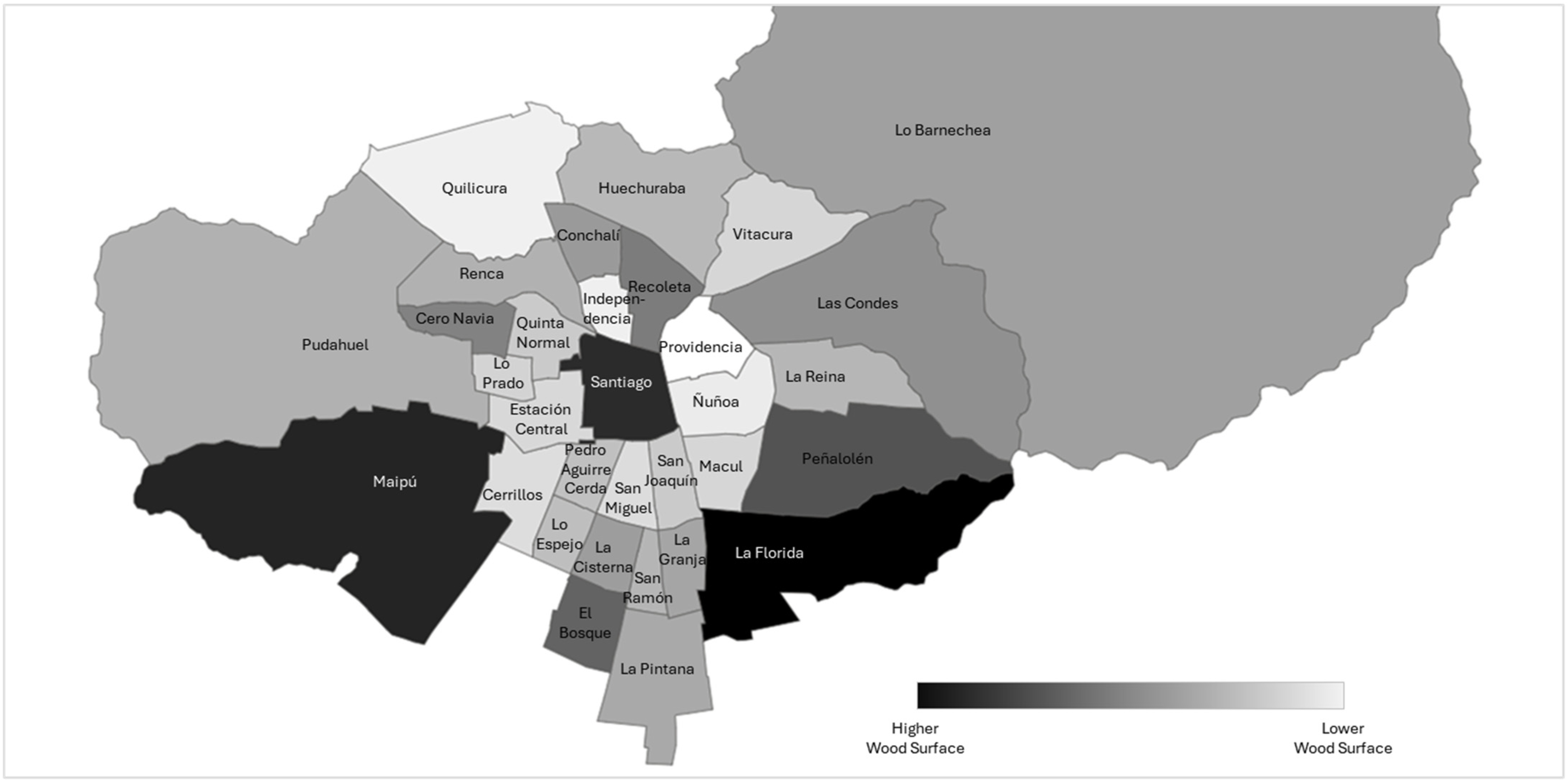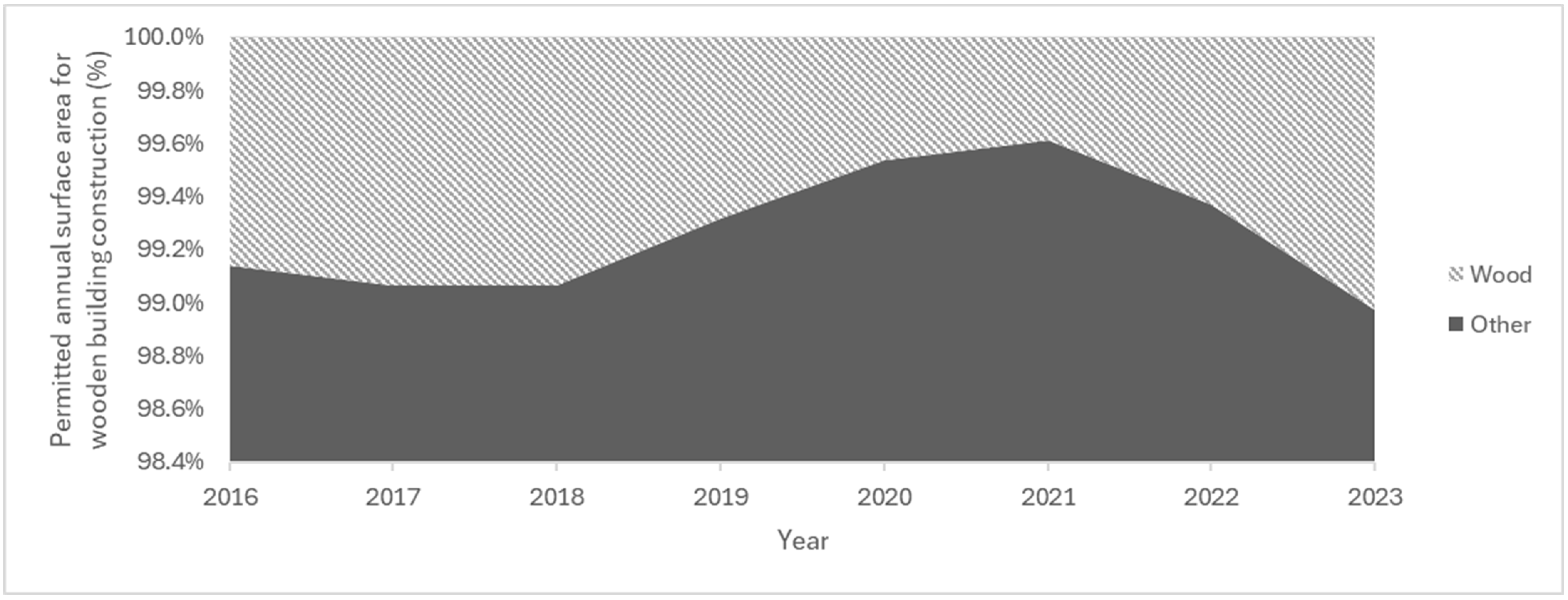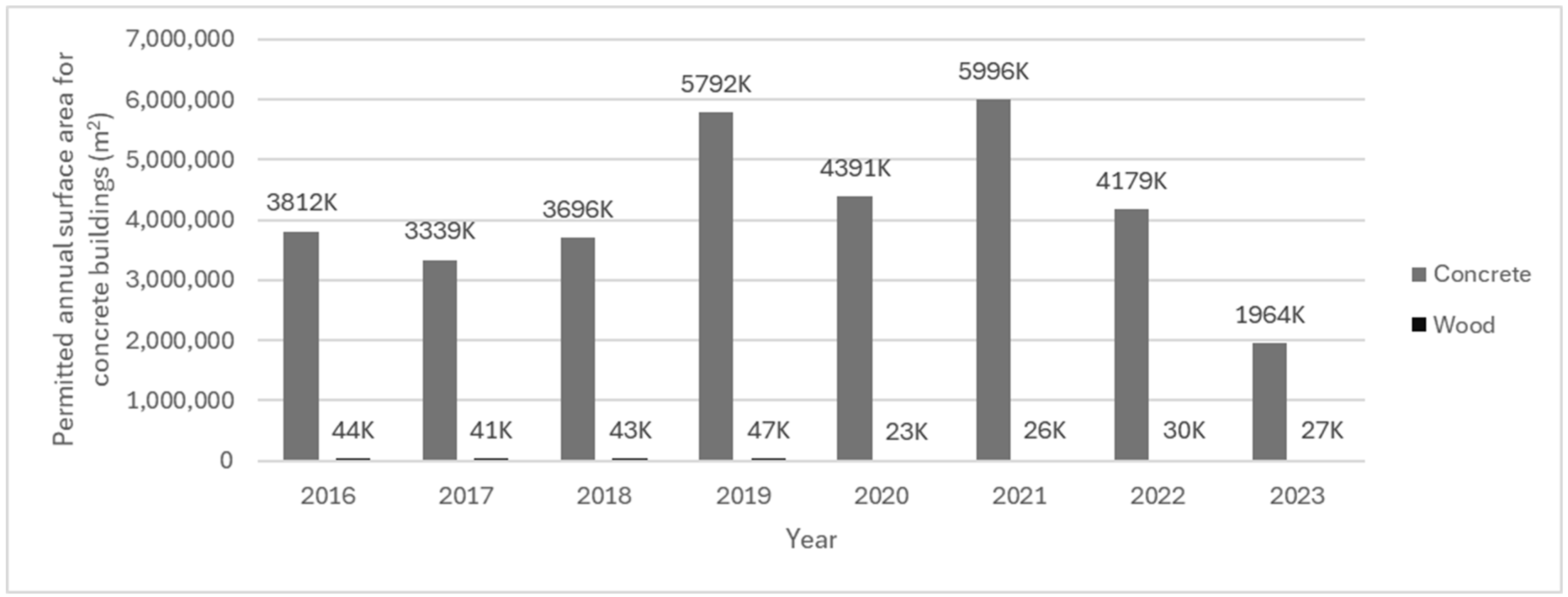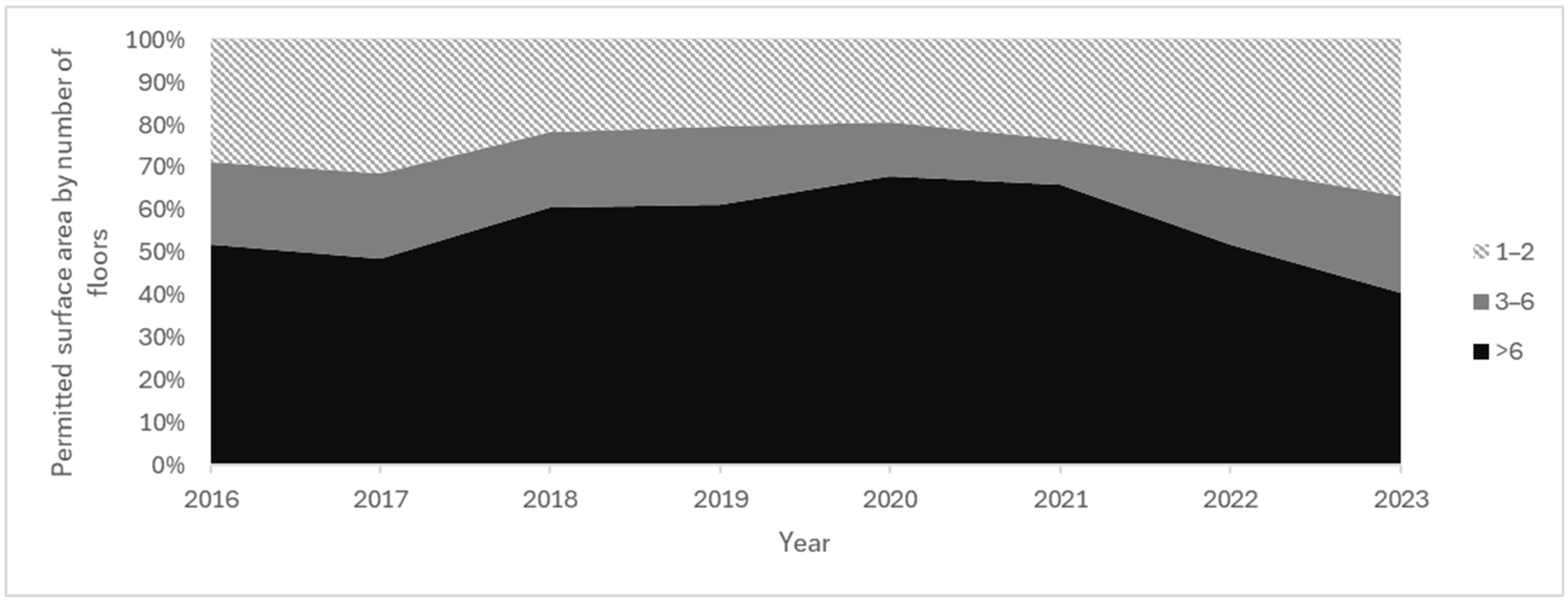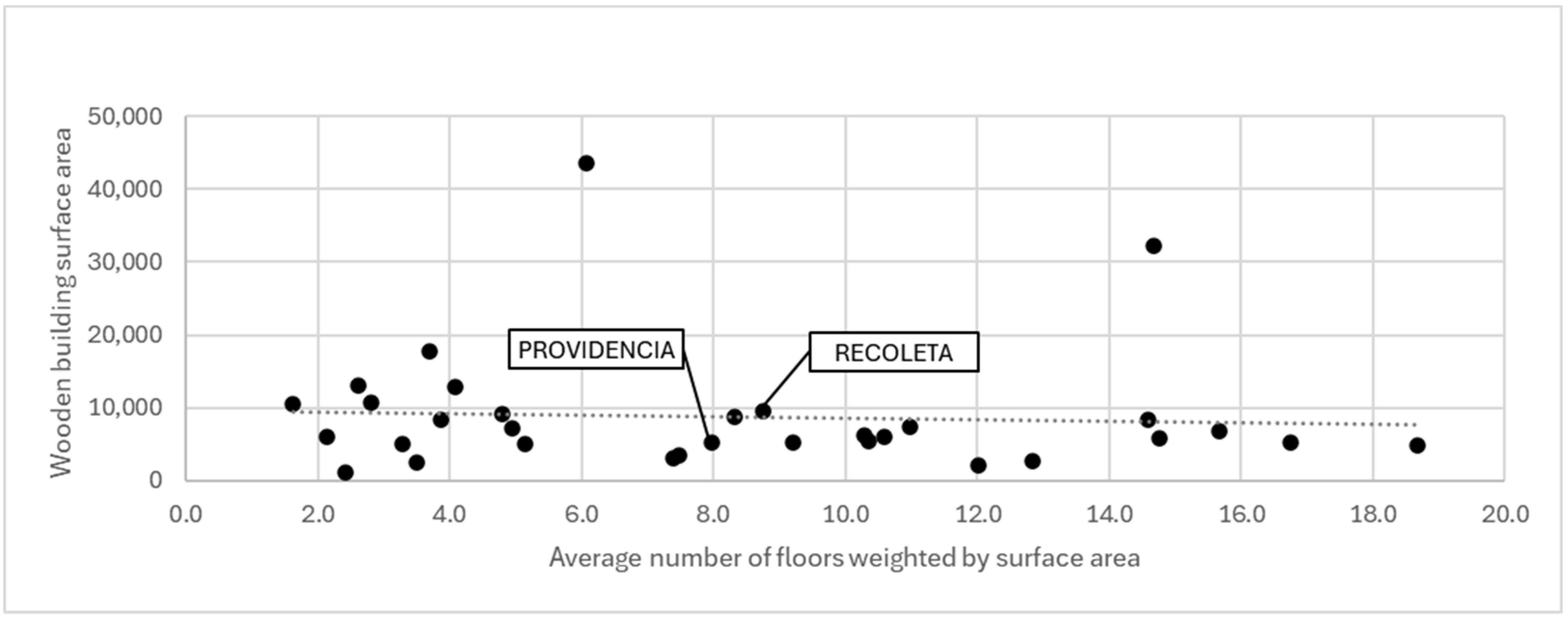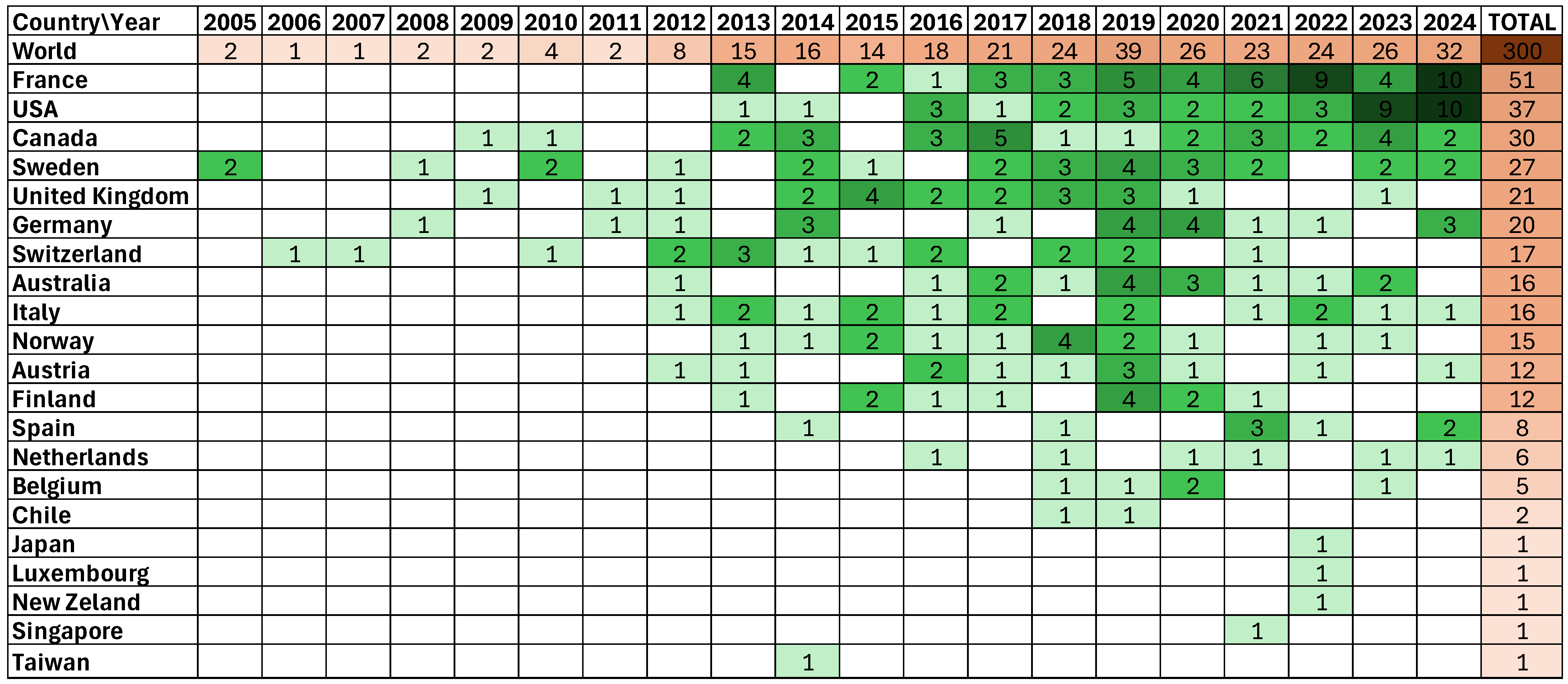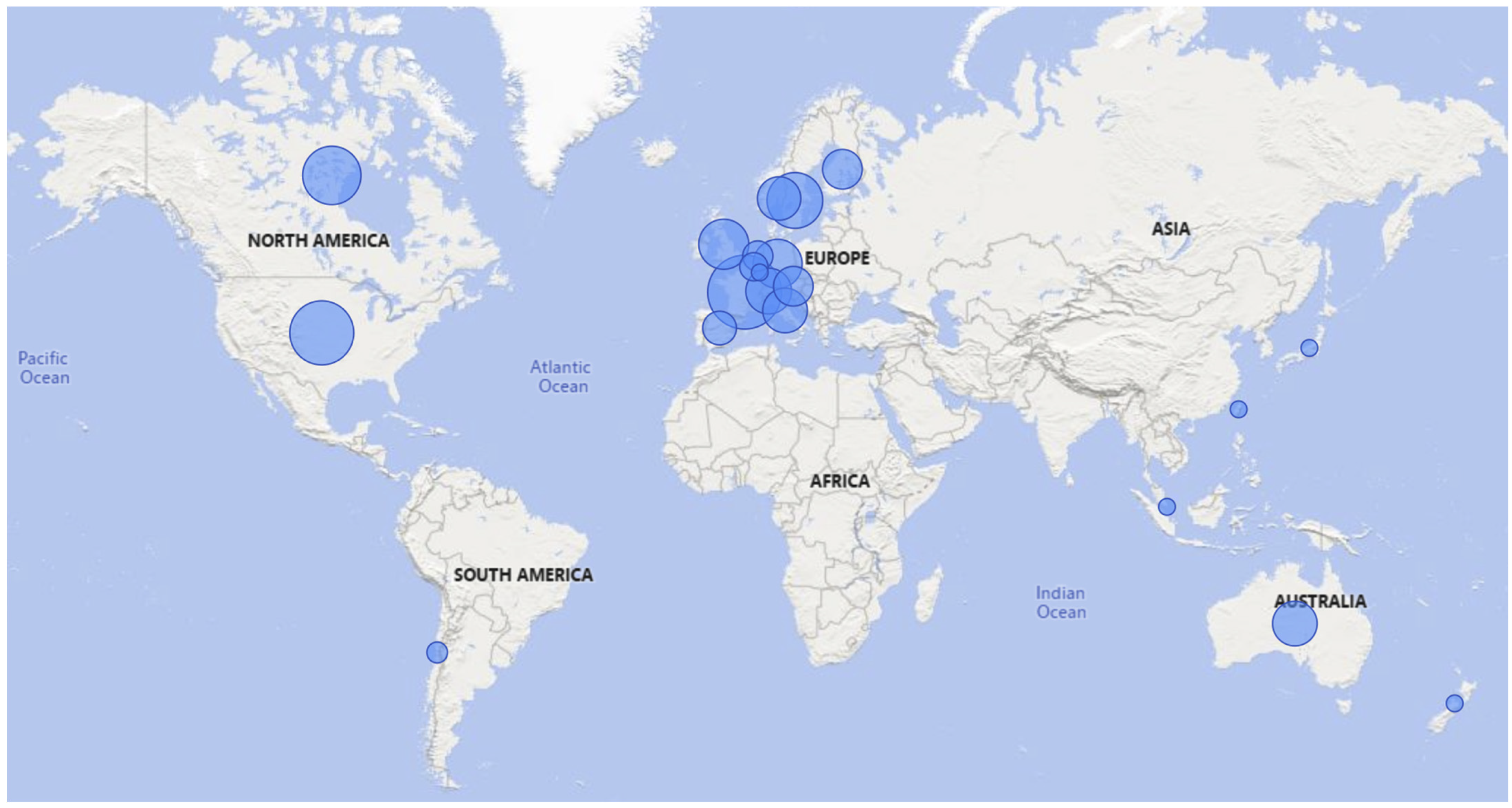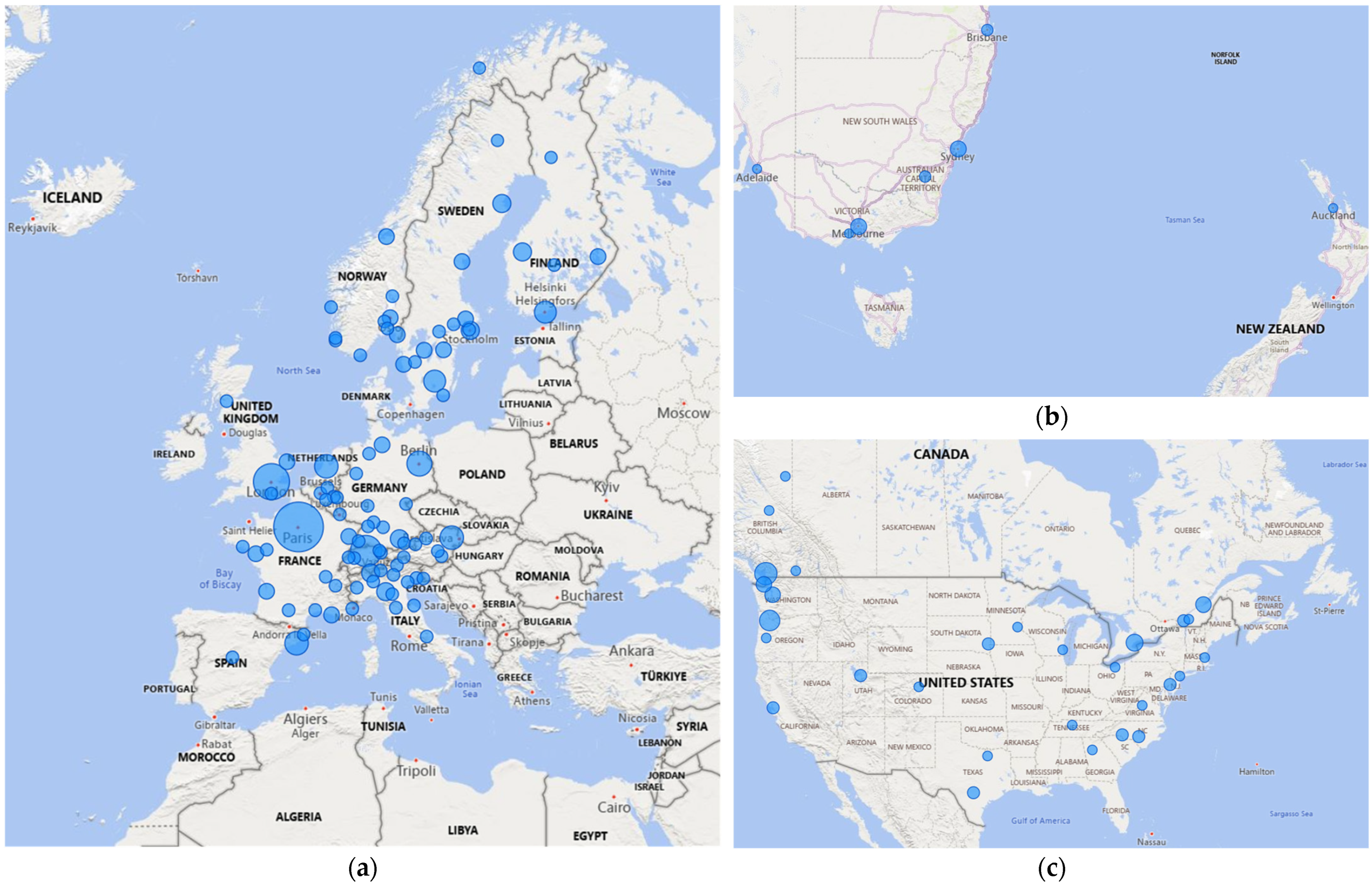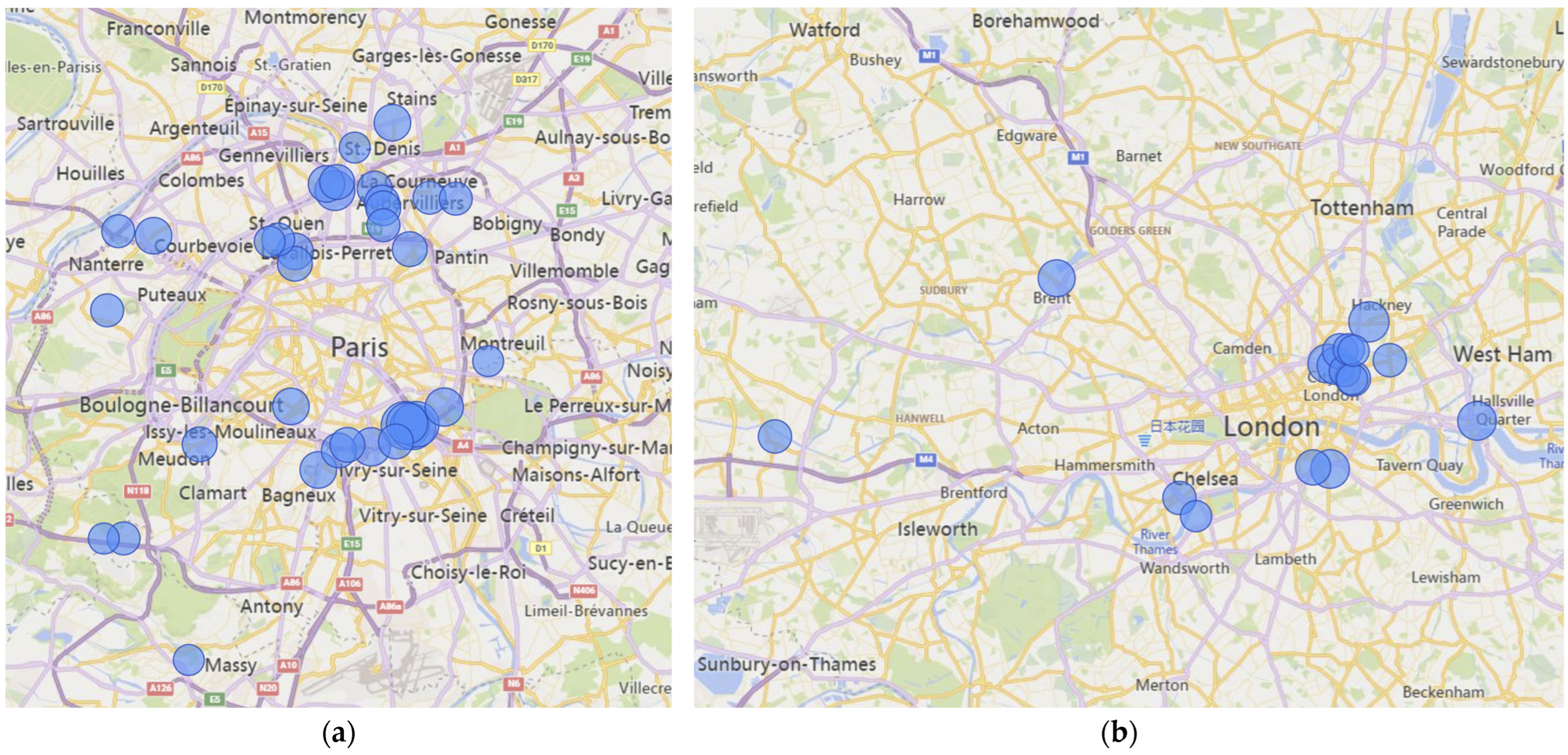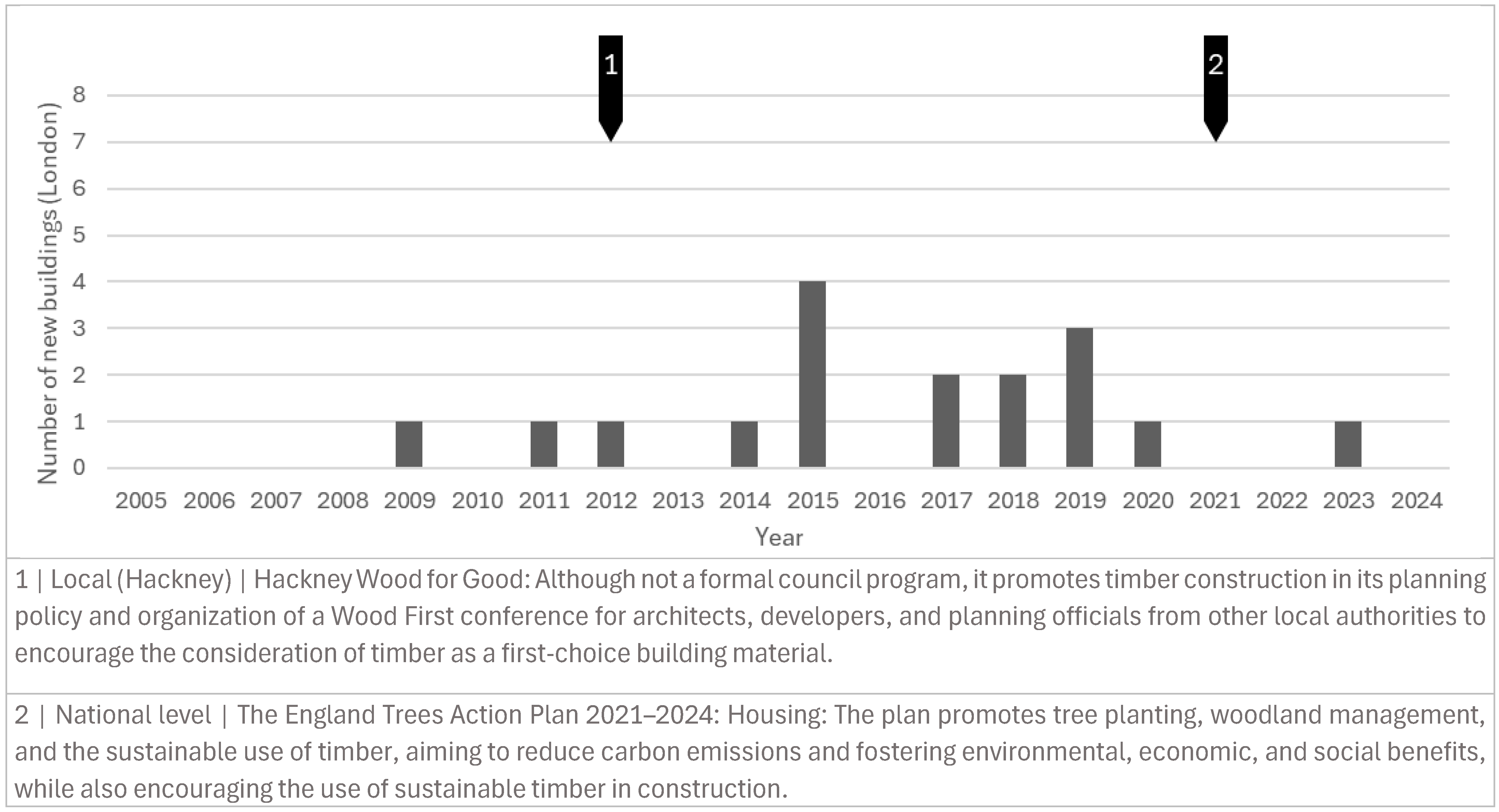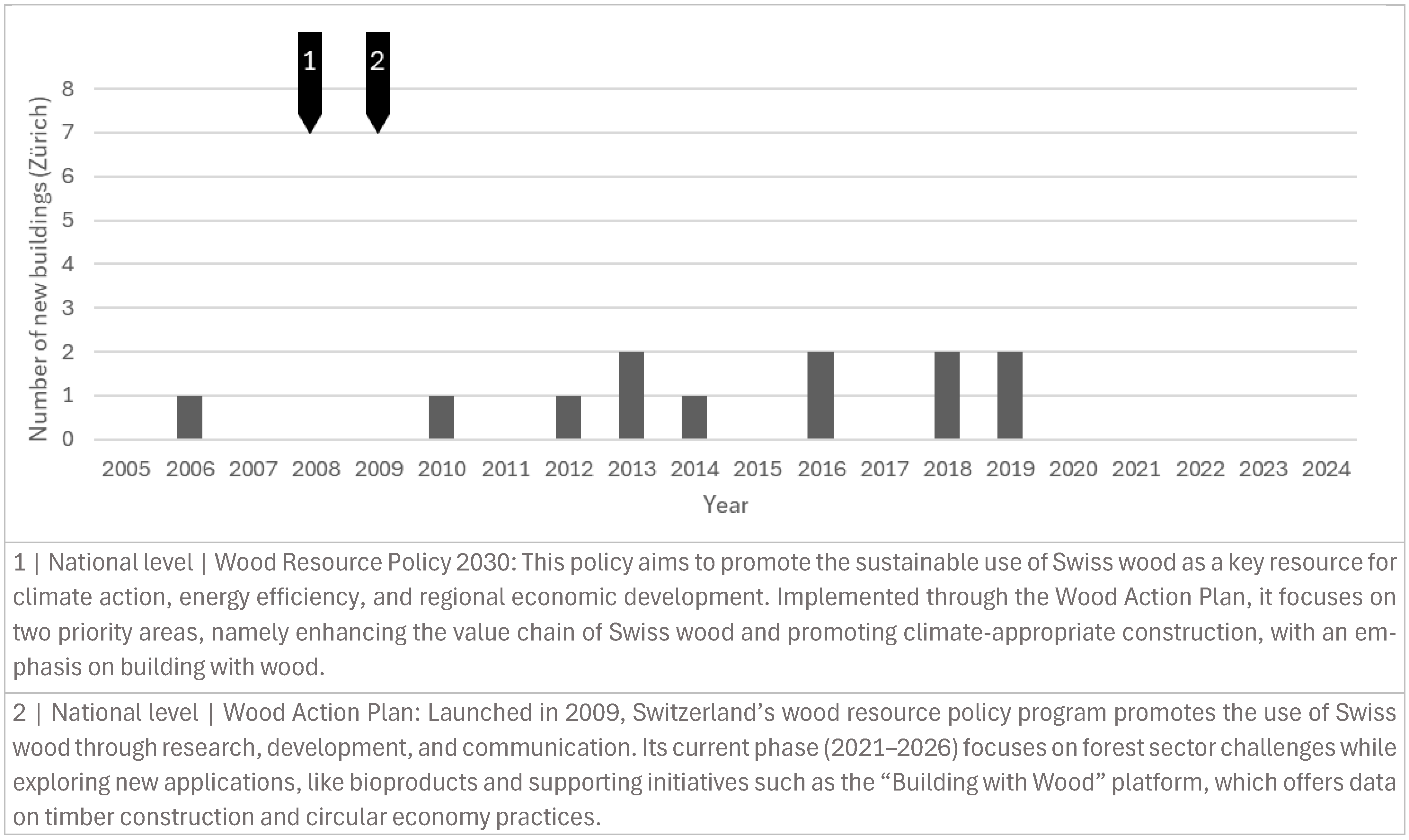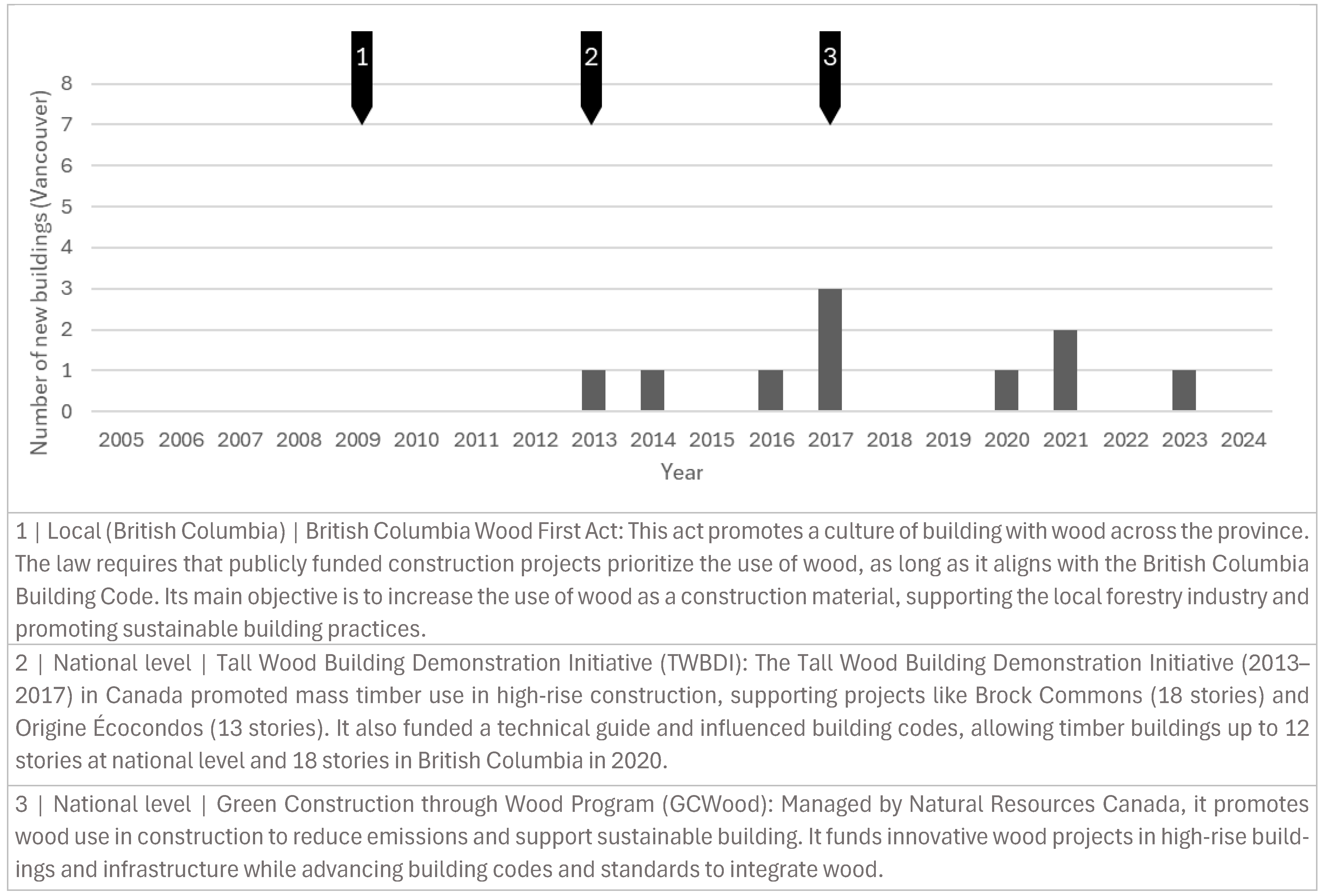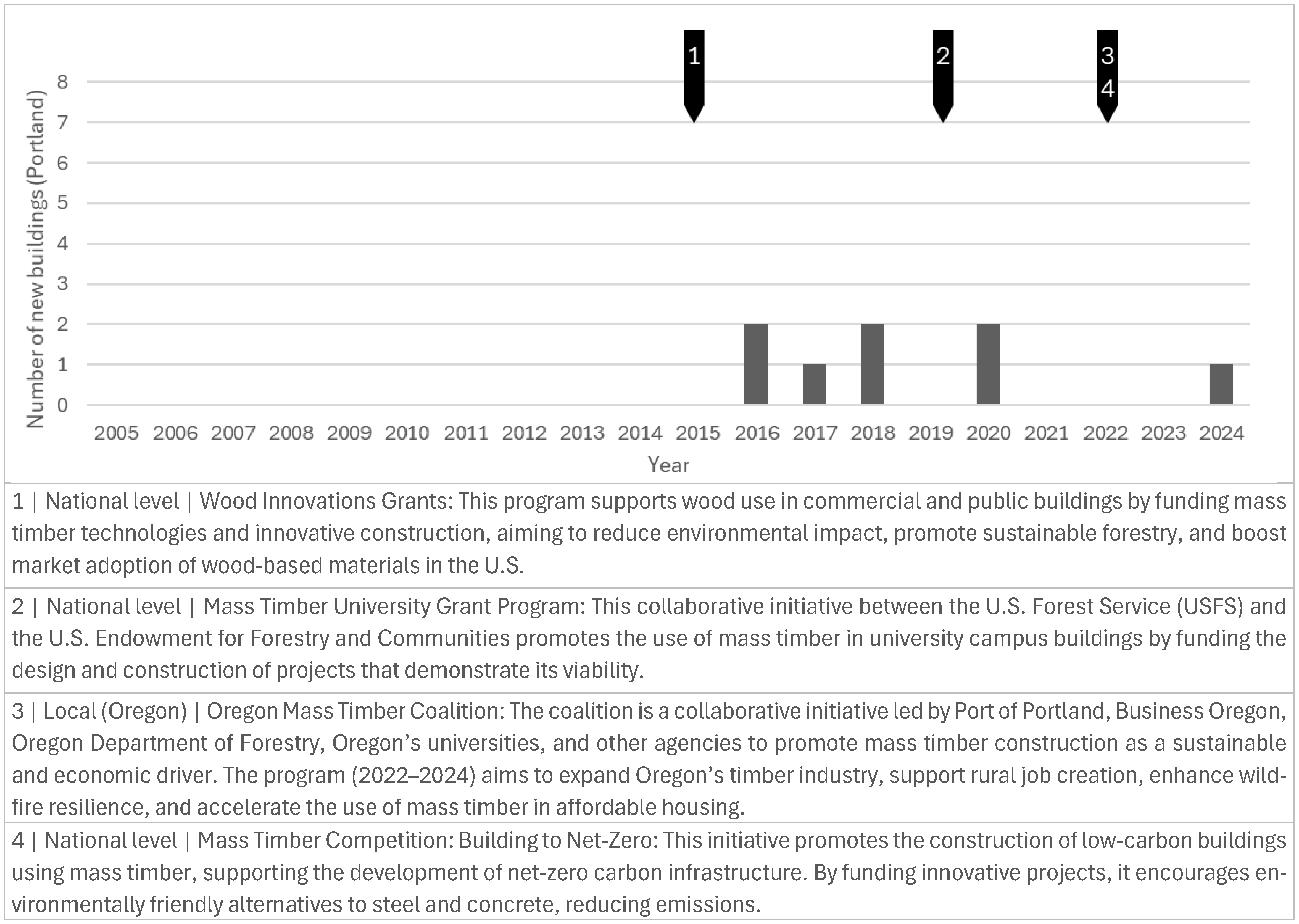1. Introduction
Wood products sourced from sustainably managed forests have proven to be a renewable alternative with lower environmental impacts compared with traditional materials heavily reliant on fossil fuels, which generate significant greenhouse gas emissions [
1,
2,
3,
4,
5]. Furthermore, promoting the use of wood products from sustainably managed forests could bolster reforestation and afforestation efforts by attracting more investors and potentially increase CO
2 capture through new forest growth [
1,
5,
6]. Additionally, their capacity to sequester carbon dioxide from the atmosphere during tree growth presents a unique opportunity for biogenic carbon storage throughout the lifespan of durable harvested wood products [
2,
4,
7,
8,
9].
Thus, wood used in construction products, particularly in structures, offers wooden buildings the ability to store substantial amounts of biogenic carbon for decades or even centuries. Furthermore, the lower greenhouse gas (GHG) emissions and reduced environmental impact associated with wooden construction processes represent significant potential for mitigating the environmental footprint of this sector [
10,
11,
12,
13,
14,
15,
16]. As a result, driven by international commitments such as the Paris Agreement, many countries have begun to implement policies that promote wood usage. These policies aim to encourage the use of sustainably harvested wood products, leading to the launching of various public initiatives that directly or indirectly support the development of wood construction.
Despite the well-known benefits of wood in buildings, many aspects remain unknown regarding how wood construction persists and evolves in the built environment. These include not only the number and distribution of wooden structures but also the factors behind their preservation or replacement, the influence of regulations, and sociocultural drivers. Questions such as how many wood structures exist in a given city and how wood inventories evolve and distribute over time often lack definitive answers. Addressing these gaps is essential for quantifying the potential benefits of urban wood and its integration into circular economy strategies, enabling governments to design effective policies that promote wood construction in specific urban contexts.
Moreover, significant differences can exist in the development of timber construction between different countries, among cities with varying contexts, or even at district or municipal level within the same urban area. In this context, the variability in urban planning regulations and public policies aimed at promoting the use of timber in construction can be decisive in specific cases. Examples such as the Hackney district in London or the municipality of Skellefteå in Sweden illustrate how adequate urban planning and regulations, combined with localized incentives, can create a favorable environment for the densification of neighborhoods with high-rise timber buildings.
Moreover, recognizing the multiple benefits of wood use in the built environment, various governments worldwide have implemented public policies aimed at promoting its application in construction. These initiatives, referred to sometimes in the literature as wood encouragement policies (WEPs), seek to establish regulatory frameworks and urban strategies that encourage the integration of wood, particularly through advanced technologies such as mass timber, in medium- and high-rise buildings [
1,
17,
18]. However, the specific effects of these policies on urban development remain insufficiently explored. Therefore, it is crucial to investigate how these initiatives can foster a greater role for wood in new constructions, especially in urban contexts undergoing densification processes, where high-rise buildings are an increasingly prominent trend.
Thus, while urban areas undergoing densification processes may experience a reduction in the built surface area of wooden structures—driven by the replacement of low-rise buildings with high-rise constructions made from materials such as concrete and steel—the adjustment of urban plans, adoption of flexible regulations, and implementation of wood promotion policies could mitigate this trend. These measures would not only facilitate an increase in the built area of wooden structures but also help reduce the environmental impact of the construction sector and promote the growth of the mass timber industry at both the local and international levels.
What is more, while the development of high-rise timber buildings has made significant progress over the past decade in developed countries across Europe, North America, and Oceania, this has not been the case in regions such as Asia, South America, and Africa. This disparity can be attributed to the fact that the former group has driven an agenda centered on material sustainability and established robust regulatory frameworks, whereas the latter often lacks these structures. Furthermore, considering that a significant portion of the new infrastructure in the coming decades will be developed in developing countries [
19], generating knowledge about the performance of timber structures in these contexts and understanding their impact on densification processes is of great interest.
This study hypothesizes that urban densification processes result in a substantial reduction in wood-based structures in the absence of targeted wood encouragement policies that promote tall timber buildings. Consequently, this work aims first to understand the dynamics of timber structures in the built environment, particularly in a city in a developing country, and how urban densification processes affect the presence of wood in building structures. Second, we identify tall wood building trends around the world and determine which countries and cities have made the greatest advances in this field. Finally, we compare tall wood building trends with specific policies that have been applied in these contexts in order to identify potential successes that could eventually be extrapolated to other urban areas, especially in developing countries. We aim to provide data and insights that contribute to the better understanding of tall wood building development in the built environment.
2. Methodology
This study aims to address the previously raised questions by analyzing the behavior of wooden constructions in the capital city of a developing country. It focuses on a city that has not yet publicly promoted tall wood construction but is beginning to generate interest among developers and the public sector. This study contrasts this city with cities in developed countries that have been advancing the expansion of tall wooden buildings over the past few decades, aiming to understand the processes that drive their development.
For this purpose, the case of Santiago, Chile—a city undergoing a densification process driven by rising land values and a growing population influenced primarily by migration patterns—was examined. Most importantly, Santiago offers comprehensive public data that can be processed for this study, namely information that is often difficult to obtain, particularly in developing countries.
To analyze data on tall wooden buildings in developed countries, an inventory was constructed using a combination of previous research reviews, publicly available databases on tall wood buildings, project catalogs from mass timber companies, architectural magazines, online platforms, and other sources. Additionally, to identify cities exhibiting relevant trends in tall wooden construction, a review of wood promotion policies was conducted to assess their potential impact on the development of tall wooden structures.
2.1. The Wood Construction Database of Santiago and the Spatiotemporal Urban Characterization of Timber Structures
Santiago (33°27′ S 70°38.90′ W) is the growing capital city of Chile, a country known for its leadership in the Latin American region, its internationally significant wood industry, and its commitments to fighting climate change, aiming to achieve carbon neutrality by 2050 [
20]. Santiago province is composed of 32 municipalities (
Figure 1), all subject to a national building code but each with its own specific urban development plans that affect them differently and are not coordinated with one another. Also, the country’s codes do not limit development based on material type, hypothetically allowing the use of wood in any kind of building as long as the minimum mandatory requirements are met.
Additionally, the city represents a noteworthy case of urban development, with a population exceeding five million. It ranks 91st out of 183 on the IESE 2024 Cities in Motion Index [
21], 53rd out of 156 in the Kearney 2024 Global Cities ranking [
22], and 119th out of 1000 on the Oxford Economics Global Cities Index [
23]. These rankings position Santiago as a leading city in Latin America, although it is still behind most major cities in developed countries, making it an interesting case study for future comparisons with other cities in developing and developed countries.
To characterize the surface area of wooden structures in Santiago—understood as the total surface area of buildings that use wood as the primary material in their bearing walls [
24]—two Chilean public databases were used to assess the extent of wood construction and identify the total square meters of timber buildings in the city. The first database corresponded to the Chilean Internal Revenue Service (SII), covering the period between 2018 and 2024 and providing comprehensive information on buildings across the entire city [
25]. This database includes details such as the building location, year of construction (final reception), primary structural materials (load-bearing elements), surface area, building use, and construction quality, classified into five predefined standards (
Table 1). Additionally, it contains supplementary data that, while available, are not directly relevant to this study.
It is important to highlight that this database, which is the most accurate source of information regarding building materials in Chile, does not include data on building heights. Furthermore, its annual records extend only up to 2018, the year in which the database was digitized and made publicly accessible for download.
The second database consists of building permits registered by the Chilean National Institute of Statistics (INE), which document authorized structures that may not necessarily have been built [
26]. Nevertheless, in contrast to the previous database, this one provides information on the number of floors for each specific project. Therefore, it allows for the identification of permits since 2002, providing details such as the building location, year of permit issuance, primary structural materials (associated with load-bearing elements), surface area, building use, and number of floors (
Table 1).
However, the INE database has limitations concerning the accuracy of the actual built environment. It does not account for buildings constructed prior to 2002 and does not confirm whether permitted structures were ultimately completed or underwent modifications during construction; Chilean building permits are valid for three years. Despite these limitations, it offers valuable insights into trends in urban development within the city, with records from the past eight years (2016–2023) considered for this work.
It is important to note that the level of detail in both databases allows for filtering information from the entire city down to the parcel level. However, all analyses were conducted at the city and municipality levels to efficiently process the large volume of data. Moreover, the two databases do not necessarily share the same definitions for each recorded variable, requiring certain adjustments for comparison. Examples of these discrepancies include differences in some identification codes and variations in the subcategories of building materials.
2.2. Tall Wood Building Inventory and Its Distribution Across Countries and Cities
To identify the cities and urban centers with the most significant development of timber buildings over the past two decades, a registry was created using databases compiled by other researchers [
27,
28,
29,
30] as a starting point, complemented by updated information gathered from online platforms that document timber projects, publications on websites specializing in architectural projects, and journals focused on architecture and construction (
Table 2).
The selected projects included timber or hybrid structures, where timber is combined with other materials such as concrete or steel, and had to have a minimum height of six floors. This criterion was based on previous research discussions regarding the minimum number of floors that define a tall timber building [
27,
31]. Additionally, the buildings had to have at least four of their floors constructed with timber structures, with timber being the material responsible for supporting the majority of gravitational loads, thereby excluding cases where most floors were built with alternative materials. Some examples of excluded buildings are tall structures that included less than four wood floors on the top, which is particularly common in some old building renovations, and structures that included concrete or steel columns with wood slabs or non-structural walls. Finally, the selected buildings had to have been fully constructed between 2000 and 2024, in order to avoid including historical structures irrelevant to subsequent analyses or unfinished projects that could distort the results.
For the purposes of this study, the registry included the following minimum entries: an identification number, the project name, year of construction, continent, country, metropolitan area (urban zone), address (not necessarily the project official address), latitude, longitude, N° of floors (counted from street level), N° of wood floors, and main gravitational structure material.
Some considerations had to be taken into account when reviewing this inventory. Although extensive efforts were made to identify tall wood projects, the dataset only included projects that were published in one of the previously reviewed registries. Additionally, since not all sources originated from official project publications, some information may have been incomplete or inaccurate, and certain details may have been outdated or modified during the building process. Moreover, given that many of these projects are relatively new, exact addresses may have been incorrect, and the completion status of some projects may have been misreported. To mitigate these issues, verification was conducted through multiple sources, including satellite imagery via Google Earth Pro, Google Street View inspections, developer-released images, and in some cases on-site visits to the projects. Nevertheless, any potential inaccuracies were expected to be limited to partial errors and should not have significantly affected the overall reliability of the dataset, given the sample size.
2.3. Identification of Wood Promotion Policies in Early-Adopter Cities of Tall Wood Buildings
Through a bibliographic review, a compilation of the main public policies aimed at promoting high-rise timber construction was carried out. This review includes publications in scientific journals, public policy dissemination documents, reports issued by public and private organizations, as well as news articles reporting on such policies. For the purposes of this registry, the public policy had to be through a specific program, initiative, or law, within a country or one of its regions, backed by a specific public body responsible for its implementation, and in effect for at least 12 months to have an impact on the development of high-rise timber projects registered in the wood building inventory.
For this purpose, any public policy aimed at promoting the use of bio-based or renewable materials in building structures was considered direct encouragement for the use of timber. Additionally, special attention was given to countries with a higher number of wood building projects to identify potential correlations. Instruments designed to promote sustainable construction in a broader sense were excluded unless they explicitly sought to reduce environmental impact through the direct use of bio-based materials or wood.
The compilation included relevant data such as the name of the public policy, country of origin, years of implementation, its geographical scope, and a brief description explaining how it promoted the development of high-rise timber buildings. Additionally, it included a classification of the public policy’s nature to identify whether it was voluntary or mandatory in relation to the use of wood in buildings. This was established with the aim of determining whether a specific project was developed after the implementation of a specific program and whether multiple projects in a specific geographic area corresponded to the same initiative.
4. Discussion
Regarding urban densification processes, where taller buildings are increasingly replacing lower ones while cities simultaneously expand into low-rise suburbs, this is a common trend observed in many cities around the world [
34,
35]. This process is largely driven by increasing land values and the availability of infrastructure needed to accommodate larger populations. Urban densification is expected to continue across most cities as long as population growth persists, supported by both rural-to-urban migration and international migration flows. In this context, approximately 55% of the world’s population currently lives in urban areas, a figure projected to rise to nearly 68% by 2050 [
36]. This expected urban growth will intensify pressures on land use and building stock, reinforcing the trend toward densification and the transformation of existing low-rise buildings into more embodied emission-intensive buildings.
As demonstrated in the case of Santiago, a city with a growing population in a developing country, densification often leads to the replacement of low-rise timber structures with taller buildings made of concrete and steel. Consequently, not only are new buildings constructed with materials that have higher embodied emissions and are used in greater quantities per square meter of urban area, but the biogenic carbon stored for decades or even centuries in existing wooden structures is also largely released. Moreover, new structures tend to require fewer wood products, which ultimately impacts the demand for sustainably harvested timber. This, in turn, undermines interest in sustainably managed forests and their potential role in long-term CO2 sequestration.
The case study also highlights the heterogeneous nature of densification across different administrative areas of a city, a pattern that is likely common in other urban contexts. Adjacent pericentral municipalities may undergo different stages of densification, resulting in varied surface areas of wood-based structures. These differences are often attributable to local urban planning regulations, which may restrict building heights in some zones while allowing taller constructions in others. Nevertheless, analysis of new construction trends indicates that densification pressure is increasingly affecting low-rise zones. Over time, this often leads to modifications in planning regulations to permit taller buildings, ultimately resulting in the replacement of low-rise wooden structures.
Thus, the 5.4% share of wood-based construction in Santiago represents a relatively low figure, particularly when compared with the national average, which according to the same dataset exceeds 20%. This indicates that the most urbanized city in the country has predominantly chosen materials other than wood, most provably due to the demands of urban infrastructure. Furthermore, the historic buildings in the city’s downtown area are mainly low-rise constructions protected under heritage preservation instruments. Meanwhile, new constructions along the city’s periphery predominantly consist of low-rise and low-complexity buildings, commonly using low-cost wood construction systems in small, detached dwellings.
On the other hand, the peri-central municipalities undergoing densification are progressing at varying rates, mostly depending on the specific urban planning regulations in place. Nonetheless, at the city level, there is a clear trend toward a reduction in building permits for wood structures. This is evident when comparing the current 5.4% wooden buildings surface area in the city to the marginal 0.7% of new building permits granted for wood-based structures in recent years. This pattern suggests a process of “de-woodification” of Santiago’s built environment, favouring the construction of taller buildings using concrete and steel.
On the other hand, in recent years, Chile has invested in developing new capacities for the production of sawn and engineered wood products, such as industrialized light-frame panels and mass timber (e.g., CLT, primarily sourced from forests which are reportedly 70% sustainably managed) [
20]. However, this alone may not be sufficient to foster the widespread adoption of high-rise timber construction in the future. In this context, the results from international building inventories indicate that although the global trend in tall timber buildings has continued—despite challenges such as the COVID-19 pandemic and subsequent economic downturns—this growth has not been uniform across countries or even between cities within the same country. This highlights that multiple factors can influence the development of timber construction, and having timber products available is only the starting point.
The analysis of the timber buildings inventory suggests that there are at least three key factors to promoting taller wood constructions, without dismissing other potential influences such as economic factors (e.g., construction costs and market conditions) or social aspects (e.g., cultural perceptions regarding living in tall wooden buildings). These three factors are as follows: (1) the supply capacity for engendered and mass timber products, whether through domestic production or competitive imports, enabling the feasibility of such projects; (2) the availability of technical expertise and building codes at the national or even municipal level, specifically addressing the design and development of mass timber buildings and all associated technical requirements; and (3) supportive public policies, especially in the initial stages, to incentivize timber construction through the development of pioneering projects that can gradually scale within the local construction industry.
In this context, the emergence and evolution of tall timber buildings over time in various cities followed distinct trajectories, which can largely be explained by the three aforementioned factors. Therefore, this work proposes a five-phase classification system to assess both the current state and the potential future development of tall timber construction in a given city, based on the number of completed buildings and their connection to these three factors. This five-phase proposal is based on the analysis of data from cities with a higher number of tall timber buildings—such as Paris, London, and Zurich—and their relationships with other cities undergoing similar processes at earlier stages.
Phase 1: Interest. This phase applies to multiple cities worldwide where developers and public stakeholders recognize the benefits of tall timber construction and express interest in its development while having access to new wood-engineered products. However, there is still a lack of local understanding of how these projects can be realized, primarily due to the absence of a first wood building catalytic case study or the fact that such projects remain in early research stages. In this context, cities like Santiago, Chile—the initial case study—while having a six-story timber frame building, do not yet reflect a true urban precedent. This is because the structure in question is a modular experimental building developed for a mining hotel in a high-altitude mountain environment under design and development conditions significantly different from those of the urban context.
Phase 2: Innovation (1–5 buildings). This phase considers the construction of about five tall timber buildings within the urban environment of a given city. The reviewed cases showed a range of 4–6 exploratory projects that had to meet all the technical and regulatory requirements of building development in accordance with local building codes. For example, in France, approximately six projects were built between 2013 and 2018 before a notable increase in construction volume occurred. These initial projects—often a couple of years apart—typically establish the technical and commercial foundation for the introduction and acceptance of this construction typology in a given market. These should be understood as catalytic projects that often do not meet all technical or commercial expectations typical of conventional developments and which sometimes require substantial public sector support to be executed. Nonetheless, data gathered from these early projects play a critical role in informing and refining building codes and regulations. A notable example is Vancouver in British Columbia, where early-stage tall timber developments contributed to the updating of building codes, ultimately enabling the construction of timber buildings up to 18 stories.
Phase 3: Early Adoption (6–20 buildings). This phase encompasses cities where between 6 and 20 tall timber buildings have been developed. At this stage, tall timber construction is no longer limited to pilot projects and has expanded to include a broader range of industry stakeholders. Here, we can identify leading cities such as London, Zurich, and Vancouver, as well as others that are just beginning to show an upward trend in tall timber building development. It is worth noting that the pace of this phase may vary significantly between cities. In some cases—such as London and Växjö—the annual number of new timber buildings has declined, partly due to changes in the local supply of mass timber products, regulatory and technical barriers, especially those concerning fire risk, and the need to revise public policies that support vertical timber development.
Phase 4: Initial Scaling (21–100 buildings). This phase includes the development of between 21 and 100 tall timber buildings, signalling increasing regulatory and market acceptance. At this stage, the ecosystem required for the deployment of such projects has matured to a level that positions timber as a viable alternative for urban high-rise development, though it may still depend on incentives or promotional policies. To date, only Paris has reached this phase—albeit in its early form—with more than 35 tall timber buildings constructed over the past decade. Progress through this phase may take many years or even decades, depending on the local real estate market and the size of the city.
Phase 5: Full Market Penetration (>100 buildings). In this final phase, a city has surpassed 100 tall timber buildings, and timber is a commonly used and competitive structural system. At this point, some of the incentives that were necessary in earlier phases may be gradually withdrawn while timber construction continues to maintain a prominent position in certain markets. As of now, none of the analysed cities have reached this level. However, cities like Paris are expected to approach this phase within the next decade, particularly due to the implementation of sustainability-oriented public policies mandating the use of wood in public buildings.
In this regard, public policies with mandatory requirements and those offering economic incentives appear to be key for advancing from Phase 2 to Phase 3, assuming that technical, regulatory, and industry capacity factors are already in place and that Phase 1 has generated sufficient technical data to inform updates to building codes and regulations. Therefore, the implementation of specific public policies in support of timber construction—while also strengthening technical capabilities—is essential to ensure the continued development of tall timber buildings over time within a given city.
When cross-referencing data from the tall timber building inventory over time with the emergence of public policies promoting wood use (
Figure 16,
Figure 17,
Figure 18,
Figure 19 and
Figure 20, cities with 8 or more tall timber buildings), it becomes evident that policies such as the French sustainability law—which mandates at least 50% bio-based materials in public buildings—and its application to numerous Olympic structures for Paris 2024 have been instrumental in advancing tall timber construction.
This resulted in the construction of more than 18 buildings between 2022 and 2024 in the French capital under mandatory policies, surpassing the 17 buildings erected in London since 2009 under information-based policies and the 12 buildings developed in Zürich through voluntary incentive policies initiated in the early 2000s. Similarly, the establishment of public-private partnerships and robust economic incentives has enabled cities such as Vancouver and Portland to develop between 8 and 10 buildings. However, these efforts still fall short of the scale observed in Paris.
Regarding the public policies promoting timber construction selected for this work, some differences can be identified between countries with strong forestry industries and those without. In forestry-rich countries, policies tend to focus more on forests and wood-based construction products as a means to support the broader wood value chain. In contrast, regions with less forest coverage are more likely to frame their timber policies around environmental incentives and commitments to climate change mitigation. As such, it is not surprising that in the forest strategies of many timber-producing countries we reviewed, the use of wood in the construction sector—particularly in relation to building height and the use of mass timber products—is a recurring theme. However, it is non-forested cities like Paris and London that, driven by sustainable development goals, emission reduction targets, and substantial infrastructure needs, have emerged as leaders in the number of tall timber buildings constructed over the past decade.
Thus, while Chile—and specifically the case study of Santiago—has made significant progress in developing technical regulations for the construction of tall mass timber buildings and has built a considerable capacity in producing industrialized light-frame panels and mass timber products, it still lacks pioneering projects that could act as catalysts for the industry, as well as specific public policies to ensure substantial growth in tall timber construction in the short and medium term. Nevertheless, targeted initiatives—such as a 10-story timber building project scheduled to begin construction in 2025 in the city centre [
37], and publications aimed at promoting policies for tall timber buildings [
38]—could serve as a stimulus to move Santiago into Phase 2 and potentially reverse the ongoing “de-woodification” process currently associated with urban densification.
Furthermore, an alternative for sustainable urban densification lies in the use of timber superstructures built on top of preexisting buildings in dense urban areas. Although the selection criteria defined for this study excluded many such cases—mainly because the number of timber floors is typically fewer than four—this strategy has gained attention in several European cities due to its light weight, reduced structural loads, and advantages in terms of construction time. Thus, although this aspect is not fully addressed in the present manuscript, future studies could explore its feasibility and regulatory implications in cities like Santiago or other similar urban contexts.
Study and Results Limitations
While this study presents a comprehensive exploration of urban wood construction and tall timber building development, several limitations may have influenced the interpretation and scope of the results. An example of this is the reliance on publicly available databases to characterize the wood-based building stock in Santiago. Although these datasets are among the most detailed in the region, they were not designed for research purposes and have constraints that may affect the resolution of the results. This could have affected the conclusion regarding Santiago’s “de-woodification” trend, as the precise magnitude of wooden surface loss and replacement remained partially inferred. Therefore, this process may be more pronounced than what is presented. Additionally, the harmonization of variables across both sources required methodological decisions that may have introduced minor classification biases.
At the international level, the global inventory of tall timber buildings may not fully capture the actual extent of the phenomenon, particularly in countries or regions where project visibility is limited or dissemination is more difficult because of factors such as language barriers. Furthermore, as timber structures become more common in certain countries, their publication becomes less frequent. Although this study applied strict inclusion criteria to ensure consistency and reliability, it is possible that some relevant projects were accidentally excluded. This may have affected the global distribution presented in the results, potentially underrepresenting certain regions. Consequently, the relative positioning of cities within the proposed five-phase framework should be interpreted as indicative rather than definitive, especially for contexts with uneven documentation practices.
Furthermore, this study proposed a qualitative association between the presence of wood promotion policies and the proliferation of tall timber buildings. While these correlations were supported by multiple examples, this study did not include a formal statistical model to test the strength or significance of these associations. This limits the ability to generalize the findings or establish causal relationships between policy types and building outputs. As a result, the identified phases of development should be seen as a conceptual tool based on observed trends rather than a rigid classification system. Future studies could build on this framework by integrating policy timing, enforcement levels, funding mechanisms, and key stakeholder interviews into multivariate models to test the policy-building link more rigorously.
Nevertheless, these limitations do not undermine the relevance of the findings. Rather, they highlight the importance of careful interpretation and the need for ongoing data collection, comparative analysis, and policy evaluation to fully understand the dynamics of urban timber structures within the built environment.
5. Conclusions
This research undertook a comprehensive examination of wood construction within the urban context of a capital city in a developing country—Santiago, Chile—framed against the backdrop of global developments in tall mass timber buildings and policy innovation. By integrating urban data, spatial distribution analysis, international case studies, and policy review, this study offers a multidimensional understanding of the limitations and potential of tall timber construction development in dense urban environments.
The findings indicate that despite Chile’s advanced forestry sector and internationally competitive wood products industry, Santiago remains in an early phase of adopting tall timber buildings in urban areas. The persistence of low-rise wooden dwellings in peripheral areas contrasts with the systematic replacement of timber structures by concrete and steel in central and pericentral municipalities. This dynamic reflects a broader pattern of “de-woodification” driven by real estate pressure, a lack of enabling policies, and—although not covered by this study—most likely cultural perceptions. The absence of iconic tall timber buildings and state-led demonstration projects reinforces this stagnation, despite the country’s recent investments in engineered wood technologies such as new CLT factories.
These results highlight a critical gap between Chile’s industrial capacity and policy leadership in contrast to cities like Paris, London, Zurich, Vancouver, or Portland, where public incentives, regulatory frameworks, and coordinated governance have accelerated timber adoption. To help interpret such trajectories, this study proposes a five-phase model of policy and market evolution. Beyond characterizing Santiago’s current position in the initial “interest” phase, this model provides a scalable and transferable framework for assessing the readiness of other cities—particularly in developing countries—to adopt tall timber construction. Its phased structure allows for cross-contextual comparisons and can support both researchers and policymakers in identifying bottlenecks, prioritizing interventions, and tracking progress over time.
In this context, replicable policy mechanisms from early-adopter cities—particularly those mandating wood use in public buildings or offering strong incentive structures—could serve as valuable references for Chilean policymakers and other developing countries. Such measures are essential not only to reverse current trends but also to harness the environmental, economic, and social benefits of timber construction amid rapid urbanization and climate change. Moreover, addressing these challenges requires a coordinated and multi-scalar policy framework that includes revising building codes to explicitly recognize and regulate engineered timber systems, providing financial incentives for early adopters, launching state-led demonstration projects—particularly in public buildings—and integrating wood construction into urban sustainability and climate strategies. Additionally, policies that promote education and dissemination efforts targeting architects, engineers, developers, and municipal officials are essential to overcoming knowledge gaps and, in some cases, cultural biases.
In conclusion, reintroducing timber into the urban fabric of a city such as Santiago is not only a question of construction technology capabilities but of political will and policy design. By learning from international examples and leveraging its own strengths, Santiago—and any mayor city in a developing country—can redefine its architectural paradigm and contribute meaningfully to a more sustainable and renewable urban future. Further research should build on this foundation by deepening, refining, and applying the proposed model to diverse international contexts, evaluating its predictive capacity, and exploring its integration into carbon accounting and circular urban design strategies.

